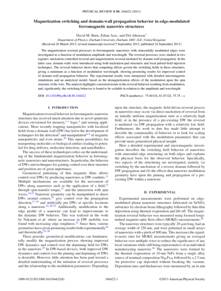
Magnetization switching and domain-wall propagation behavior in edge-modulated ferromagnetic nanowire structures
D.M. Burn, E. Arac and D. Atkinson
Phys. Rev. B 88, 104422 (2013)
DOI: 10.1103/PhysRevB.88.104422
The magnetization reversal processes in ferromagnetic nanowires with sinusoidally modulated edges were investigated as a function of modulation amplitude and wavelength. The reversal processes were studied in two regimes: nucleation controlled reversal and magnetization reversal mediated by domain-wall propagation. In the latter case, domain walls were introduced using both nucleation-pad structures and local pulsed-field injection techniques. The reversal behavior shows that competing effects govern the switching fields in these structures, giving a minimum as a function of modulation wavelength, showing promising results for improved control of domain-wall propagation behavior. The experimental results were interpreted with detailed micromagnetic simulations and an analytical model, based on the demagnetization effects of the modulation upon the spin structure of the wire. The analysis highlights consistent trends in the reversal behavior resulting from modulation, and, significantly, the switching behavior is found to be scalable in relation to the amplitude and wavelength.